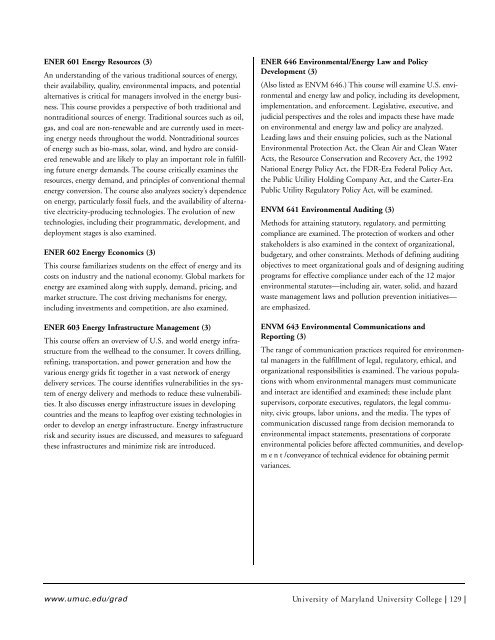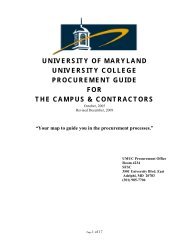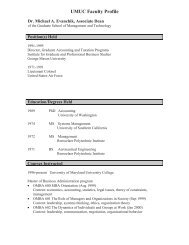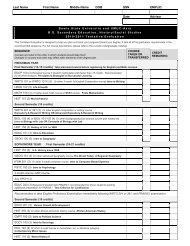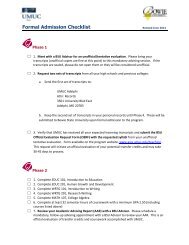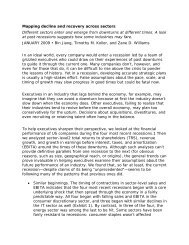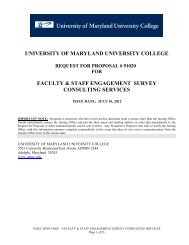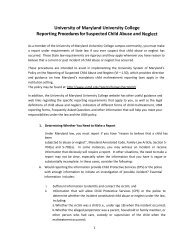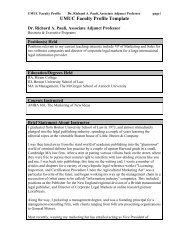A+B. Intro_SJ.1 - University of Maryland University College
A+B. Intro_SJ.1 - University of Maryland University College
A+B. Intro_SJ.1 - University of Maryland University College
You also want an ePaper? Increase the reach of your titles
YUMPU automatically turns print PDFs into web optimized ePapers that Google loves.
ENER 601 Energy Resources (3)<br />
An understanding <strong>of</strong> the various traditional sources <strong>of</strong> energy,<br />
their availability, quality, environmental impacts, and potential<br />
alternatives is critical for managers involved in the energy business.<br />
This course provides a perspective <strong>of</strong> both traditional and<br />
nontraditional sources <strong>of</strong> energy. Traditional sources such as oil,<br />
gas, and coal are non-renewable and are currently used in meeting<br />
energy needs t h roughout the world. Nontraditional sources<br />
<strong>of</strong> energy such as bio-mass, solar, wind, and hydro are considered<br />
renewable and are likely to play an important role in fulfilling<br />
future energy demands. The course critically examines the<br />
re s o u rces, energy demand, and principles <strong>of</strong> conventional thermal<br />
energy conversion. The course also analyzes society’s dependence<br />
on energy, particularly fossil fuels, and the availability <strong>of</strong> alternative<br />
electricity-producing technologies. The evolution <strong>of</strong> new<br />
technologies, including their programmatic, development, and<br />
deployment stages is also examined.<br />
ENER 602 Energy Economics (3)<br />
This course familiarizes students on the effect <strong>of</strong> energy and its<br />
costs on industry and the national economy. Global markets for<br />
energy are examined along with supply, demand, pricing, and<br />
market structure. The cost driving mechanisms for energy,<br />
including investments and competition, are also examined.<br />
ENER 603 Energy Infrastructure Management (3)<br />
This course <strong>of</strong>fers an overview <strong>of</strong> U.S. and world energy infrastructure<br />
from the wellhead to the consumer. It covers drilling,<br />
refining, transportation, and power generation and how the<br />
various energy grids fit together in a vast network <strong>of</strong> energy<br />
delivery services. The course identifies vulnerabilities in the system<br />
<strong>of</strong> energy delivery and methods to reduce these vulnerabilities.<br />
It also discusses energy infrastructure issues in developing<br />
countries and the means to leapfrog over existing technologies in<br />
order to develop an energy infrastructure. Energy infrastructure<br />
risk and security issues are discussed, and measures to safeguard<br />
these infrastructures and minimize risk are introduced.<br />
ENER 646 Environmental/Energy Law and Policy<br />
Development (3)<br />
(Also listed as ENVM 646.) This course will examine U.S. environmental<br />
and energy law and policy, including its deve l o p m e n t ,<br />
implementation, and enforcement. Legislative, executive, and<br />
judicial perspectives and the roles and impacts these have made<br />
on environmental and energy law and policy are analyzed.<br />
Leading laws and their ensuing policies, such as the National<br />
Environmental Protection Act, the Clean Air and Clean Water<br />
Acts, the Resource Conservation and Recovery Act, the 1992<br />
National Energy Policy Act, the FDR-Era Federal Policy Act,<br />
the Public Utility Holding Company Act, and the Carter-Era<br />
Public Utility Regulatory Policy Act, will be examined.<br />
ENVM 641 Environmental Auditing (3)<br />
Methods for attaining statutory, regulatory, and permitting<br />
compliance are examined. The protection <strong>of</strong> workers and other<br />
stakeholders is also examined in the context <strong>of</strong> organizational,<br />
budgetary, and other constraints. Methods <strong>of</strong> defining auditing<br />
objectives to meet organizational goals and <strong>of</strong> designing auditing<br />
programs for effective compliance under each <strong>of</strong> the 12 major<br />
environmental statutes—including air, water, solid, and hazard<br />
waste management laws and pollution prevention initiatives—<br />
are emphasized.<br />
ENVM 643 Environmental Communications and<br />
Reporting (3)<br />
The range <strong>of</strong> communication practices required for environmental<br />
managers in the fulfillment <strong>of</strong> legal, regulatory, ethical, and<br />
organizational responsibilities is examined. The various populations<br />
with whom environmental managers must communicate<br />
and interact are identified and examined; these include plant<br />
s u p e rvisors, corporate exe c u t i ves, regulators, the legal commun<br />
i t y, civic groups, labor unions, and the media. The types <strong>of</strong><br />
communication discussed range from decision memoranda to<br />
environmental impact statements, presentations <strong>of</strong> corporate<br />
environmental policies before affected communities, and deve l o p-<br />
m e n t /conveyance <strong>of</strong> technical evidence for obtaining permit<br />
variances.<br />
w w w. u m u c . e d u / g r a d<br />
Un i versity <strong>of</strong> Ma r yland Un i versity <strong>College</strong> | 129 |


